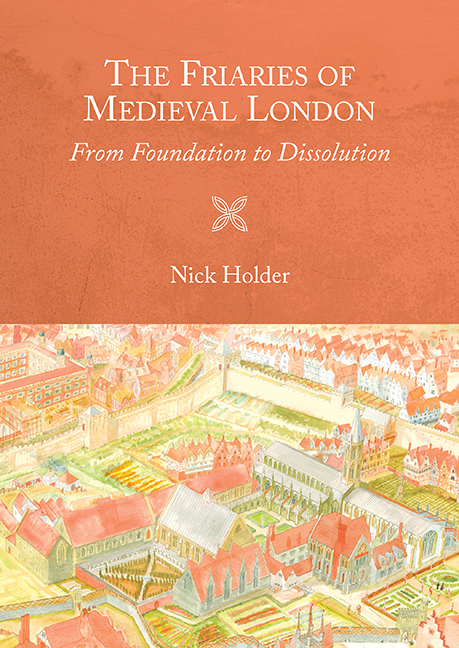Book contents
- Frontmatter
- Contents
- List of Illustrations and Tables
- Contributors
- Acknowledgements
- Abbreviations
- Introduction
- Part I The Nine London Friaries
- 1 The First Black Friars in Holborn, c. 1223–86
- 2 The Second Black Friars, 1275–1538
- 3 The Third Black Friars at St Bartholomew's, 1556–9
- 4 Grey Friars, 1225–1538
- 5 White Friars, c. 1247–1538
- 6 Austin Friars, c. 1265–1538
- 7 Crossed Friars, c. 1268–1538
- 8 Sack Friars, c. 1270–1305
- 9 Pied Friars, 1267–1317
- Part II The London Friars and their Friaries
- Conclusions
- Timeline
- Bibliography
- Index
- Miscellaneous Endmatter
1 - The First Black Friars in Holborn, c. 1223–86
from Part I - The Nine London Friaries
Published online by Cambridge University Press: 16 May 2018
- Frontmatter
- Contents
- List of Illustrations and Tables
- Contributors
- Acknowledgements
- Abbreviations
- Introduction
- Part I The Nine London Friaries
- 1 The First Black Friars in Holborn, c. 1223–86
- 2 The Second Black Friars, 1275–1538
- 3 The Third Black Friars at St Bartholomew's, 1556–9
- 4 Grey Friars, 1225–1538
- 5 White Friars, c. 1247–1538
- 6 Austin Friars, c. 1265–1538
- 7 Crossed Friars, c. 1268–1538
- 8 Sack Friars, c. 1270–1305
- 9 Pied Friars, 1267–1317
- Part II The London Friars and their Friaries
- Conclusions
- Timeline
- Bibliography
- Index
- Miscellaneous Endmatter
Summary
THE Castilian priest Dominic of Caleruega (sometimes referred to with his probably aristocratic name of de Guzmán) founded a new religious order in the second decade of the thirteenth century. Dominic was an Augustinian canon and his new order grew out of his band of priests (which also included Cistercian monks) who were combating the Cathar heresy in the Languedoc. Dominic's way of dealing with the heresy was through itinerant, straightforward and organised preaching. This Dominican order of friars shared many characteristics with St Francis’ new order founded in the same decade in Italy. The Dominicans quickly began to expand their order throughout Europe, moving from Toulouse to Paris and to Spain. They came to England in 1221 and the first friar to arrive in London was Gilbert de Fresnay in August. He began to look for a suitable site for a new priory, which was to be the second friary in England after the Oxford house. De Fresnay quickly found a powerful supporter. Hubert de Burgh, earl of Kent, was the royal justiciar – senior minister to Henry III, who was still a minor. De Burgh purchased and then gave to the friars a parcel of land in suburban Holborn, just by the bridge over the Fleet river. The donation was confirmed with a quitclaim, datable to the mayoral term of October 1223 to October 1224, although the grant itself may well have been slightly earlier. Although this was not a city-centre location, the site occupied a prominent position on the main approach to London from the west, and was only 320m from the Newgate entrance into the city (Figure 3, Figure 4). Furthermore, the proximity to the bridge over the Fleet gave the friars a good opportunity to provide spiritual services to travellers and, potentially, receive alms in return.
The Dominicans in England have long been known as Black friars, the colour referring to the cloak they wore outside the friary. The numbers of these London Black friars quickly increased in the period when the Holborn friary was being constructed and used. By 1243 there were about eighty Dominicans in London, although in 1278 numbers were down to sixty. When the Black friars left their Holborn friary in the 1280s, there may have been sixty-seven friars.
- Type
- Chapter
- Information
- The Friaries of Medieval LondonFrom Foundation to Dissolution, pp. 15 - 26Publisher: Boydell & BrewerPrint publication year: 2017



